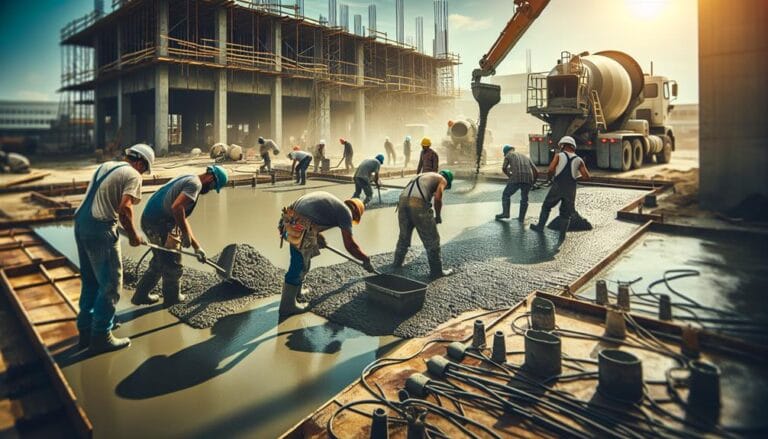Expert Contractors for Slab on Grade Construction
We specialize in identifying expert contractors for slab-on-grade construction. It all starts with meticulous site preparation and grading to guarantee a strong and level surface. Next, we consider the slab design based on site and structure requirements. We then carefully select durable, high-strength concrete materials tailored to the load and local weather conditions. From there, we execute precise concrete laying and finishing. Additionally, proper drainage management systems are essential, and we test and enforce quality control measures to guarantee a long-lasting and safe foundation. If you're looking for experts in slab-on-grade construction, you've got the right place.
Key Takeaways
- Expert contractors ensure proper site preparation, including excavation, compaction, and fine grading, for a stable foundation.
- Robust design and material selection consider load, drainage, and environmental factors to guarantee a long-lasting slab.
Site Preparation and Grading
As we begin our slab on grade construction journey, the unsung heroes of site preparation and grading set the stage for success. These processes are essential in guaranteeing that the concrete slab is laid on a stable and level surface. For a slab on grade (SOG) to be successful, the site must be thoroughly prepared, starting with excavation and soil compaction techniques. Grading contractors bring the site to rough grade through excavation, fill placement, and compaction. This step is significant, as uneven or unstable ground can cause settlement and thereby compromise the slab's integrity.
Once the site is at the rough grade, fine grading is completed by the concrete contractors. They ascertain that the surface is precise and level for the slab to be poured. Proper soil compaction techniques play a fundamental role in preventing settlement and cracking over time. Incorrect compaction can cause long-term issues, so site preparation must be performed meticulously and with attention to detail. By doing so, we provide a solid foundation for our slab on grade construction.
Slab Configuration and Design
We move on to configuring and designing the perfect slab-on-grade by carefully evaluating the site and structure requirements, ensuring a strong and resilient foundation. Slab-on-grade foundations are a popular choice for both residential and commercial projects, offering a number of advantages over other foundation methods. When designing the slab, we consider the slab thickness, which typically ranges from 4 to 6 inches, depending on the load bearing needs and environmental factors.
To enhance energy efficiency, we explore insulation options such as foam board insulation, radiant barrier insulation, or the use of an insulated slab form. This helps to reduce heat loss and minimize the risk of moisture-related issues. The design stage is vital in determining the lifespan and performance of the slab. We pay close attention to factors like soil settlement, drainage, and potential risks from natural disasters. By carefully balancing these considerations, we create a robust and long-lasting slab-on-grade foundation that serves as a solid base for any building project.
Concrete Material Selection
In selecting concrete materials for slab-on-grade construction, we prioritize durability, strength, and resistance to environmental factors, guaranteeing a robust foundation that supports the structure and withstands climate-specific issues. Choosing the right concrete mix is vital in achieving these goals. The concrete mix should be designed to accommodate the load-bearing requirements of the structure, as well as the local weather conditions.
When selecting materials, we focus on durability, as it directly affects the long-term performance and lifespan of the slab. We consider factors such as the type of cement, water-cement ratio, and the incorporation of additives like fly ash and silica fume to improve strength and resistance to degradation. This guarantees that the concrete will maintain its integrity in the face of weather-related stress and various environmental conditions.
Ultimately, material durability is our primary concern in slab-on-grade concrete material selection. By selecting the right concrete mix and materials, we can guarantee that the slab will provide a solid foundation for the structure, even in harsh environments, and yield long-term benefits including low maintenance and economic efficiency.
Laying and Finishing Concrete
When laying and finishing concrete for slab-on-grade construction, we perform thorough site preparation and arrange for precise placement and finishing techniques to guarantee accurate leveling and uniform surface quality. Key initial steps include compacting the subgrade and subbase to confirm sturdy support for the concrete slab, and then laying a vapor barrier to prevent moisture migration and potential damage. For precise concrete placement, we use advanced tools like laser screeds and power trowels to maintain consistent thickness, allowing for a smooth and even finish.
Post-pouring, concrete curing is critical for long-term durability. We confirm that the concrete is properly cured by applying a curing compound, thereby protecting it from the elements and allowing it to achieve its intended strength. Our attention to detail in surface finishing confirms that the slab is both visually appealing and structurally sound. Meticulous finishing techniques and quality control measures are implemented to achieve the required level of flatness and smoothness. Our all-encompassing approach to laying and finishing concrete confirms a high-quality slab on grade that can stand the test of time.
Drainage Management Systems
To guarantee that water does not accumulate under the slab and compromise its integrity, effective drainage management systems play a critical role in slab on grade construction. We emphasize the importance of implementing adequate drainage solutions to prevent water accumulation around the property. This involves careful planning and execution to ascertain proper water flow away from the house.
A well-designed drainage system not only enhances the durability of the slab but also maintains a safe and healthy environment. By directing water flow towards a specific area, it reduces the likelihood of water seepage under the slab, which can cause mold, mildew, and structural issues. Effective water management requires meticulous attention to details during the construction process, including the installation of expansion joints, grading, and waterproofing methods.
Our experienced contractors devise and execute extensive drainage management systems, ensuring that all necessary measures are taken to protect your property from water damage. By integrating advanced drainage solutions into our construction processes, we ensure long-term structural integrity and a safe living space.
Testing and Quality Control
We meticulously test and inspect our drainage management systems to confirm they meet the highest quality standards. For slab on grade construction, verifying that our drainage systems are correctly installed and functioning properly is fundamental to preventing water damage and structural issues. This involves employing a range of techniques, including non-destructive testing to check for any defects or leaks.
Our quality assurance process involves rigorous inspections throughout each stage of construction to identify and address any potential issues before they become major problems. We confirm that all our equipment, including pumps and pipes, meet the necessary specifications and are regularly maintained to minimize the risk of failure.
Slab Maintenance and Repair
For slab on grade construction, prudent maintenance and regular repairs are essential to extend its lifespan and mitigate structural issues. We recognize that effective maintenance involves a thorough inspection of the concrete surface, checking for signs of wear and tear, and addressing any issues promptly. This includes identifying and addressing cracks early on, which can help prevent further damage. By incorporating methods like surface sealing, we can enhance the durability and appearance of the slab.
Our expertise in slab maintenance and repair guarantees that we can diagnose and address potential problems before they escalate. We utilize advanced techniques to seal the surface, protecting it from environmental factors and minimizing the likelihood of future cracks. Our detailed inspections cover not only the slab itself but also its surrounding areas, allowing us to identify and correct issues related to soil settlement, drainage, and other external factors that might impact the slab's integrity.
Safety Regulations and Compliance
During concrete slab construction and ongoing maintenance, compliance with stringent safety regulations remains vital to confirm the well-being of the construction team and those using the structure. It's important to make certain that everyone involved adheres to well-established safety protocols to minimize the risk of accidents and guarantee the structural integrity of the building. This includes proper training for contractors on safety practices, including fall protection, electrical safety, and personal protective equipment usage. In addition, regular inspections must be conducted to verify compliance with established standards and regulations.
Adherence to compliance standards is equally significant. Contractors should be familiar with local, state, and national building codes to make certain that their work meets or exceeds the required standards. This includes making sure that all necessary permits are obtained and canceled inspections are passed to prevent unintended problems. At Cooper & Company General Contractors, we take safety regulations and compliance extremely seriously, knowing that the health and safety of everyone involved depends on our attention to these details.
Frequently Asked Questions
Can a Slab-On-Grade Foundation Be Used on Any Soil Type?
While it's tempting to think a slab-on-grade foundation works on any soil, we find that's not entirely true. The foundation's stability depends on the soil type; some soils, like clay, can cause issues with uneven settlement and cracking.
How Do Slab-On-Grade Foundations Handle Seismic Activity?
When it comes to seismic resilience, it is understood that slab-on-grade foundations are designed to handle seismic activity by distributing the forces evenly and providing foundation stability.
Are Slab-On-Grade Foundations Suitable for Multi-Story Buildings?
When constructing multi-story buildings, we question whether slab-on-grade foundations can provide the necessary structural integrity. They're suitable for smaller structures but for taller ones, confidence wavers, like trust in a reed instead of a sturdy oak tree. Familiarity with seismic activity helps, but multi-story feasibility still has its doubts.
What Are Common Methods for Preventing Rodent Infestation Under Slab Foundations?
'We emphasize rodent barriers and integrated pest management strategies to prevent infestations under slab foundations. We seal all entry points, including utility gaps, and guarantee clean and debris-free sites during construction to minimize risks.'
Can a Home Builder Modify the Slab Design Mid-Construction?
While it's possible for us to modify the slab design mid-construction to prevent rodent infestation, these changes will impact our construction timeline.







